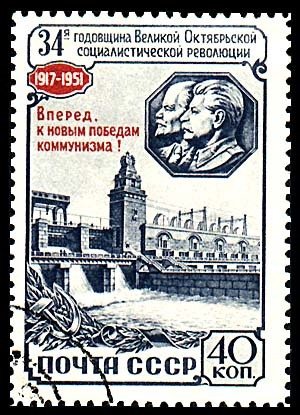Stamp: The dam and bas-relief of Lenin & Stalin (Soviet Union, USSR 1951)
The dam and bas-relief of Lenin & Stalin (Soviet Union, USSR 1951)
01 January (Soviet Union, USSR ) within release 25th Anniversary of Volkhov Hydroelectric Plant goes into circulation Stamp The dam and bas-relief of Lenin & Stalin face value 40 Russian kopek
| Stamp The dam and bas-relief of Lenin & Stalin in catalogues | |
|---|---|
| Michel: | Mi:SU 1599 |
Stamp is square format.
Also in the issue 25th Anniversary of Volkhov Hydroelectric Plant:
- Stamp - The dam and bas-relief of Lenin & Stalin face value 40;
- Stamp - Kakhovka Hydroelectric Power Plant face value 20;
- Stamp - Volga-Don canal's map and hydroengineering construstions face value 30;
- Stamp - Dam of Stalingrad Hydroelectric Power Plant face value 40;
- Stamp - Main Turkmen Canal [unbuilt] and cotton-plants face value 60;
- Stamp - Equestrian statue of Jan Žižka in Praha face value 20;
- Stamp - Monument to soldiers of Soviet Army in Ostrava face value 25;
- Stamp - Julius Fučík (1903-1943), Czechoslovak author face value 40;
- Stamp - Building of Bedřich Smetana Museum in Praha face value 60;
- Stamp - Volkhov Hydroelectric Plant named after V.I. Lenin face value 40;
- Stamp - Budapest: Liberty Bridge face value 25;
- Stamp - Budapest: Parliament face value 40;
- Stamp - Budapest: National Museum face value 60;
- Stamp - Combine harvester face value 25;
- Stamp - Meadow, grasses, insects and beehive face value 40;
- Stamp - Citrus harvesting face value 1;
- Stamp - M.I. Kalinin Museum in Moscow face value 20;
- Stamp - Mikhail I. Kalinin (1875-1946), Soviet statesman face value 40;
- Stamp - Felix E. Dzerzhinsky (1877-1926), Soviet statesman face value 40;
|
Data entry completed
43%
|
|
|---|---|
| Stamp The dam and bas-relief of Lenin & Stalin in digits | |
| Country: | Soviet Union, USSR |
| Date: | 1951-01-01 |
| Format: | Stamp |
| Face Value: | 40 Russian kopek |
Stamp The dam and bas-relief of Lenin & Stalin it reflects the thematic directions:
A head of state (or chief of state) is the public persona that officially represents the national unity and legitimacy of a sovereign state. In some countries, the head of state is a ceremonial figurehead with limited or no executive power, while in others, the head of state is also the head of government. In countries with parliamentary governments, the head of state is typically a ceremonial figurehead that does not actually guide day-to-day government activities and may not be empowered to exercise any kind of secular political authority (e.g., Queen Elizabeth II as Head of the Commonwealth). In countries where the head of state is also the head of government, the president serves as both a public figurehead and the actual highest ranking political leader who oversees the executive branch (e.g., the President of the United States).
An economy is an area of the production, distribution and trade, as well as consumption of goods and services. In general, it is defined as a social domain that emphasize the practices, discourses, and material expressions associated with the production, use, and management of resources. A given economy is a set of processes that involves its culture, values, education, technological evolution, history, social organization, political structure, legal systems, and natural resources as main factors. These factors give context, content, and set the conditions and parameters in which an economy functions. In other words, the economic domain is a social domain of interrelated human practices and transactions that does not stand alone.
A dam is a barrier that stops or restricts the flow of surface water or underground streams. Reservoirs created by dams not only suppress floods but also provide water for activities such as irrigation, human consumption, industrial use, aquaculture, and navigability. Hydropower is often used in conjunction with dams to generate electricity. A dam can also be used to collect or store water which can be evenly distributed between locations. Dams generally serve the primary purpose of retaining water, while other structures such as floodgates or levees (also known as dikes) are used to manage or prevent water flow into specific land regions.
Communism (from Latin communis, 'common, universal') is a left-wing to far-left sociopolitical, philosophical, and economic ideology within the socialist movement, whose goal is the creation of a communist society, a socioeconomic order centered around common ownership of the means of production, distribution, and exchange that allocates products to everyone in the society based on need. A communist society would entail the absence of private property and social classes, and ultimately moneyand the state (or nation state).




